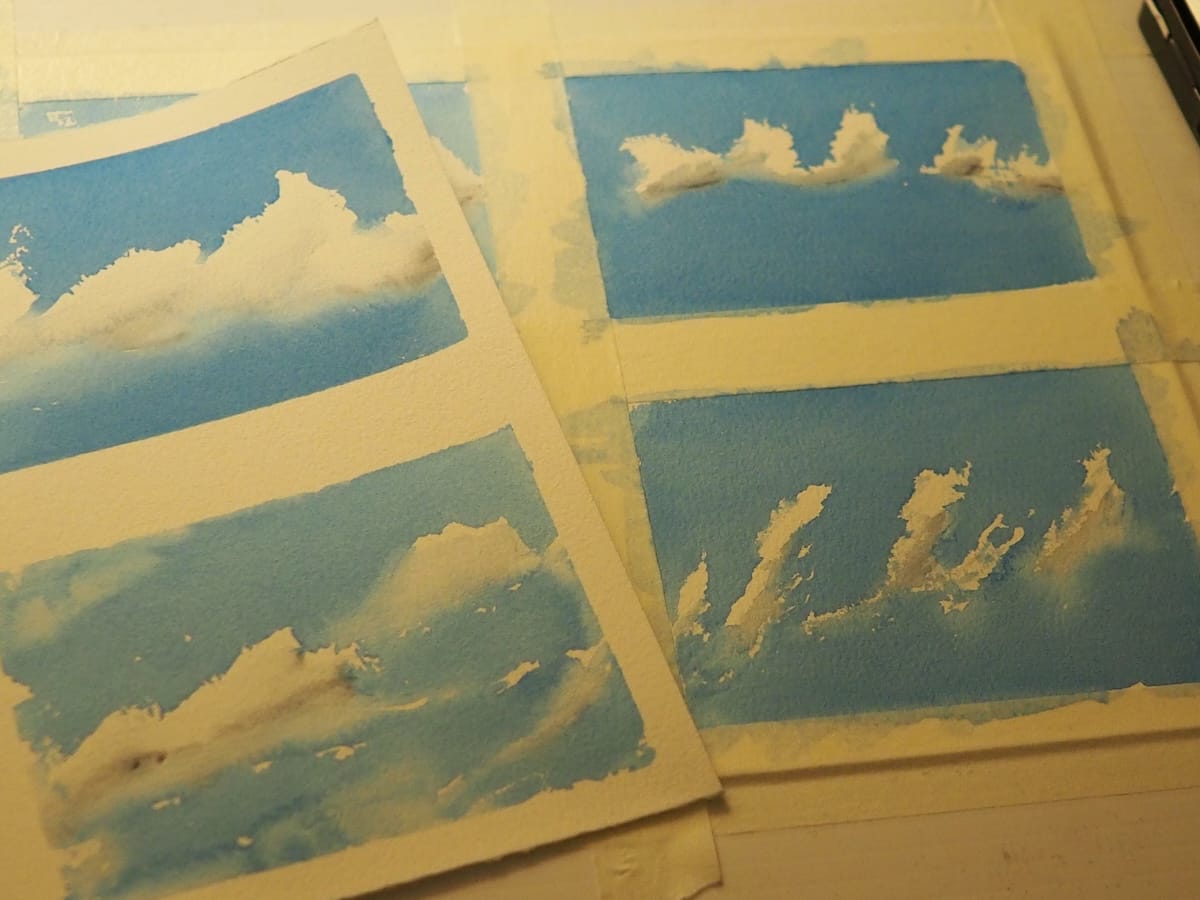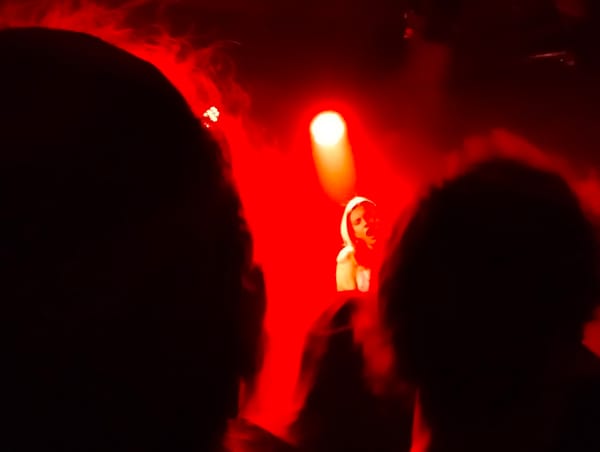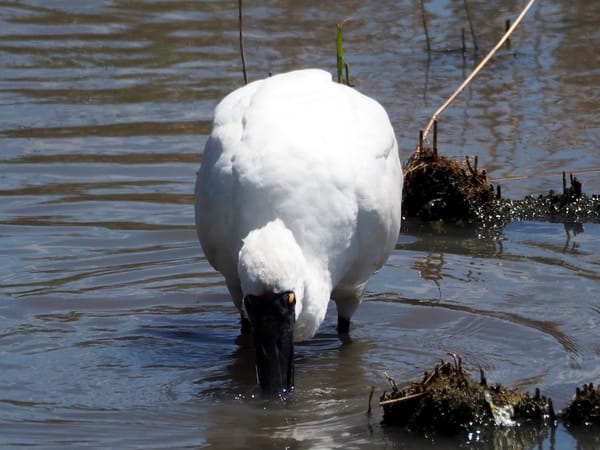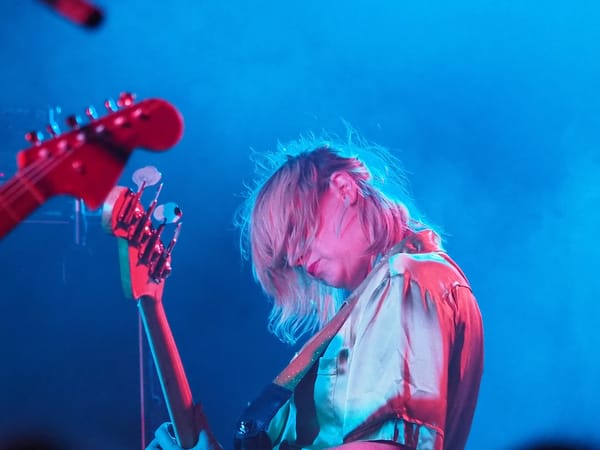Cloud practice

A thing that bugs me about a lot of watercolour video tutorials is they only show the part where the brush hits the paper. That leaves more than half of the process out and too many unanswered questions, like what colours did they use, and how much water? What does the palette look like? What kind of brush, and how much did they dunk it in their mixture?
Lately I have been practicing painting clouds, and I'm gratified by the results so far. I thought I would make a record of how I did them. Despite beginning by complaining about videos, I'm going to forget that altogether and describe it in the form of a (this) blog. I'll try to describe the whole process, including the obvious bits.
The paint and water mixture
I have been using Winsor and Newton Cotman paints, replacing them with higher-quality brands when I run out of a colour. The cloud practice paintings were done with Cotman Intense Blue (Phthalo Blue), a colour I have up until now been entirely ignoring in favour of pretty much every other blue in the paint set.
But now I am changed—I think Intense Blue looks great and really pops against the paper white. I also used a tiny bit of Payne's Grey, a shade that I use all the time. Both are transparent colours, and one day I will understand the significance of that fact.
I mixed a generous amount of the blue, and tried not to be shy about how much paint I used. I didn't want it to be pale and insipid. I also definitely don't want to run out while painting, so I made a generous puddle.
I also made a weak mix of Payne's Grey. Not too much of this is needed.
The brush
I used one of my larger brushes, a size 10 Micador round taklon brush. Sizes are not standard, but a Micador 10 is about the same as a Winsor and Newton Sceptre Gold II 10, though the Micador has more of a point at the tip.
I probably also used some smaller brushes after slopping around the blue. I have a size 6 Micador round sable brush (my favourite) and a little Sceptre Gold II rigger whose size is no longer legible.
The water
I needed two jars of water. One was used to rinse the paint off the brush, and the other kept clean. I always have two jars of water when I paint, but I needed to be more fastidious than usual in this case. Don't put the brush in the clean water unless it's been rinsed well in the dirty jar.
Hitting the page
I aimed to make the sky very uniform with no visible brushstrokes. For this, I loaded up the brush with plenty of the blue mixture, as much as it would carry, to make sure it stayed wet while I was working. That way I could expand the area of blue without leaving any edges in it. It's important to keep working and not let the edges of painted area dry until they are told to.
For the clouds, I created ragged edges of blue against the paper white. For this I was a bit mean to my brush, using the butt and scraping about with the tip so my edges were as messy as possible. I also took care to brush out any bubbles that formed on the page from my enthusiastically ragged brushing. For edges that looked too neat, I worked them again until I got a ragged, messy edge.
You can see in the image, the bottom left iteration, I completely failed to paint the blue nicely. I think I left some bubbles behind which popped and left a cauliflower, or I did something else silly that dropped too much water in and pushed the blue away. Mistakes are good as long as you know what went wrong.
I aimed to leave the tops of the clouds sharp against the white, but blend the bottoms of the clouds into the white of the paper. This is where the clean water comes in. Wet the white area of the cloud—not much water, or it will push the blue in unwanted directions—and then move the brush towards the blue underneath the cloud to soften its edge and blend it. The blue should fade to white before it runs out of wet white, so that it doesn't create a new edge.
For most of the iterations above I didn't really succeed in blending the blue upwards into the cloud beautifully. Except for the top right one, which is pretty good in that regard. I put too much clean water on the page and it pushed the paint down away from the cloud. But clouds are unpredictable things so I can probably claim I meant to do that, right?
While the bottom of the cloud was still a bit wet, I added a teensy bit of the Payne's Grey mix to give a bit of shade and volume. The sun is probably above the clouds relative to the viewer after all, so the bottom of the cloud should be darker. Again, it's important that the grey is wet enough to blend but not so wet it travels. It would be fun to add other colours here and give the clouds some golden hour qualities or the impression of holding rain, things I will try another time.
Stop and look
The final thing is to stop! It's best to practice clouds one iteration at a time, taking a few moments to look at the dried painting, think about what did and didn't go well with the process, and improving on the next attempt.
My final note to myself is to start really looking at clouds and skies more. What shape are the clouds? What unexpected colours appear? How does the sky change between the horizon and up? What does it mean?



